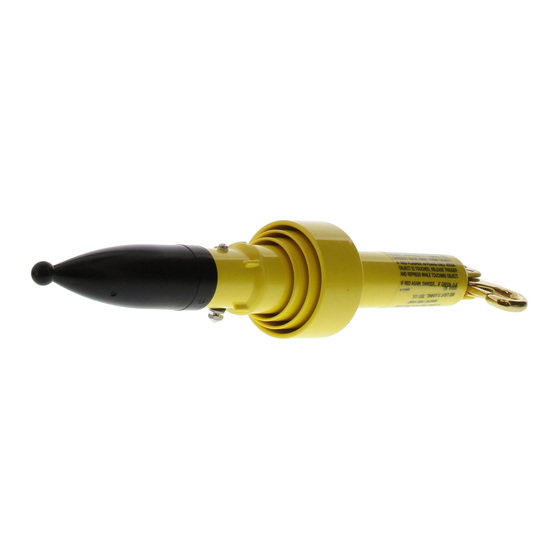
Table of Contents
Advertisement
Quick Links
Advertisement
Table of Contents

Summary of Contents for Fluke C9970
- Page 1 C9970 Voltage Detector Users Guide *1286912* PN 1286912 (English) May 2007 Rev. 6, 11/2021 (English) ©2007-2021 Fluke Corporation. All rights reserved. Specifications are subject to change without notice. All Product names are trademarks of their respective companies.
- Page 2 The warranty extends only to the original buyer or end user customer of a Fluke Networks authorized reseller, and does not apply to any product which, in Fluke Networks’ opinion, has been misused, abused, altered, neglected, contaminated, or damaged by accident or abnormal conditions of operation or handling.
-
Page 3: Contact Fluke
Introduction The C9970 Voltage Detector (the Product) is a high-voltage probe used for detecting hazardous voltage on objects such as power ground wires, street light fixtures, mobile homes, metal frameworks, metal conduit, pedestals, newly-driven ground rods, homes covered with metallic siding, and electrical machinery. - Page 4 Do not drop the Product or subject it to severe mechanical stress which may damage the protective insulation or internal circuitry. If the Product fails a test described in Periodic Performance Checks, do not use the Product and contact Fluke. See Contact Fluke.
- Page 5 Voltage Detector Symbols Do not expose the Product to extreme temperatures (below -40 °C or above +60 °C) or chemicals that may soften, crack, or otherwise damage the plastic housing. Although the Product is water resistant, do not expose it to water. If ...
-
Page 6: Theory Of Operation
C9970 Users Guide Theory of Operation The Product uses electronics and a high-voltage mechanical design to indicate the presence of dangerously-high ac and dc voltages. To do so, the Product first determines the voltage difference between the body of the user and the object under test. - Page 7 Voltage Detector Accessories Figure 1. Features of the Product LEDs (red and green) Ground terminal Trigger Probe Check contact Conductive Flashguard Instruction Belt end cap label clip Accessories The section below describes how to use some of the accessories available for use with the Product.
- Page 8 C9970 Users Guide To connect the Bond: 1. Put on insulating gloves. 2. Connect the small clamp to a reliable ground source such as a cable suspension strand. 3. Use the Product to test a metallic object such as a fixture, conduit, or bare vertical ground wire and verify there is no voltage present before you connect the Bond.
- Page 9 Warning If the Product fails the self check or test plug threshold test, do not use the Product. Contact Fluke to repair or verify the integrity of the Product. Self Check Test If the Product fails a step below, do not continue with the test.
-
Page 10: Use The Product
C9970 Users Guide Figure 2. Self Check Test Test Plug Threshold Test To do a test plug threshold test: 1. Do a self check test. See Self Check Test. 2. Use an ohmmeter to verify the integrity of the Plug. The resistance from the test point to either or both of the two prongs should be 300 KW ±1 %. - Page 11 Voltage Detector Use the Product Figure 3. Hold the Product AC Hazardous Voltage Tests Warning Do not make contact exposed bare wire with the metal tip of the probe. The Product detects hazardous ac voltage conditions at 60 Hz. At frequencies <60 Hz, the Product requires higher voltages to detect a hazardous condition.
- Page 12 C9970 Users Guide Warning Avoid unsecured objects, dangling wires, etc., which can move if probed. While you try to get an accurate reading through the corrosion, the object may suddenly swing around and hit you. 4. To avoid false indications due to static electrical discharge, maintain contact with the Product and the object as you release the trigger and push and hold the trigger again.
- Page 13 Voltage Detector Applications 5. Hold the probe tip against the object. If needed, turn the Product from side to side to make a reliable contact. Paint, other surface finishes, or corrosion may interfere with the connection. 6. To avoid false indications due to static electrical discharge, maintain contact with the Product and the object as you release the trigger and push and hold the trigger again.
- Page 14 C9970 Users Guide Ground Level Mobile homes, trailers, metal sheath buildings, ground rods and electrical machinery all present potential electrical hazards and always require testing. Before starting any work operation, test the skin and frame (or both frames in the case of double wide mobile homes).
- Page 15 Voltage Detector Applications Base of Pole: Telephone Plant Repairs Before you climb a telephone pole, verify there are no hazards. On the telephone pole or adjacent spans, examples of hazards include but are not limited to potential electrical hazards such as a vertical power ground wire, vertical metallic power conduit, street light fixture, power company primary disconnect hardware, or other foreign metal objects, improper clearance from power conductors or equipment, dangling power wires, inadequate clearance on pole-to-pole guys...
-
Page 16: Battery Replacement
C9970 Users Guide Battery Replacement When replacing batteries, work in a dry place. Replace with an IEC 6F22 carbon- zinc battery. Caution Some 9 V batteries may be slightly oversized. If an oversized battery is installed, the metal shield can separate from the circuit board. If the replacement battery seems tighter than the original, use a different brand of battery.









